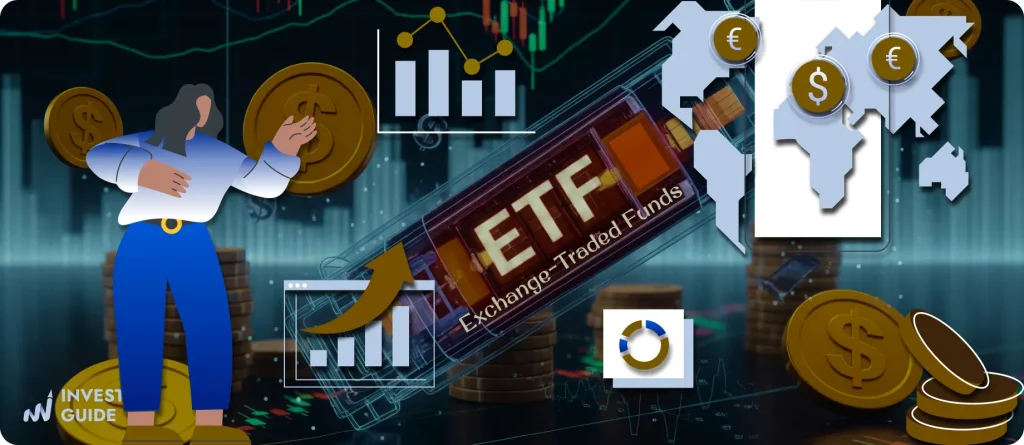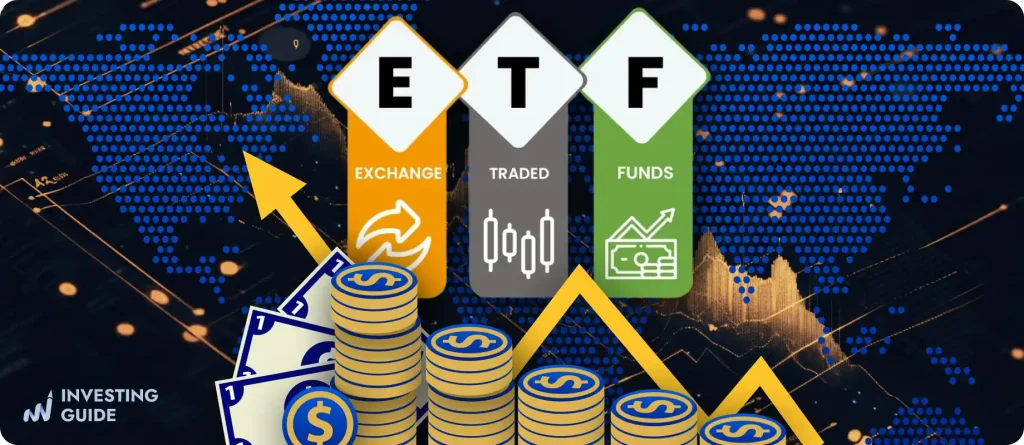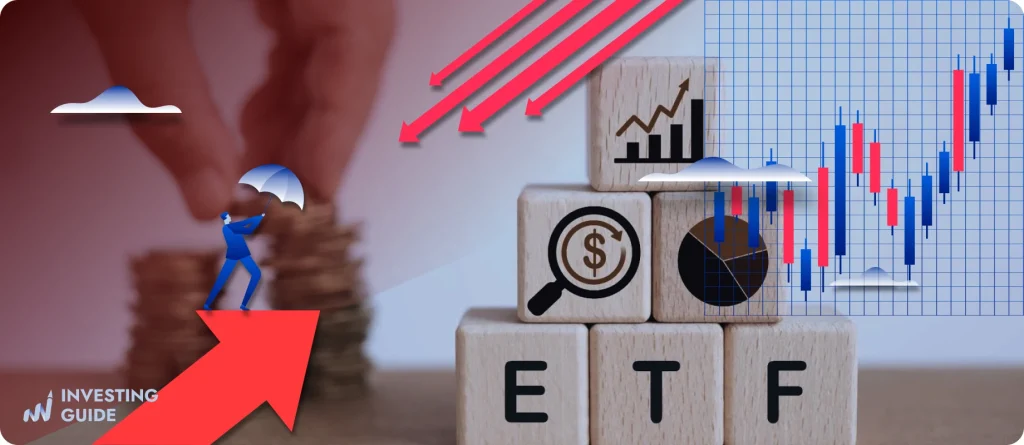Yulia Pavliuk is a financial content writer with a background in language, education, and clear communication. She creates SEO-friendly articles that make complex finance topics like ETFs and forex signals clear and accessible, with a strong focus on UK audiences.
We may receive compensation from our partners for placement of their products or services, which helps to maintain our site. We may also receive compensation if you click on certain links posted on our site. While compensation arrangements may affect the order, position or placement of product information, it doesn’t influence our assessment of those products.
Navigating the investment landscape in the UK presents both opportunity and complexity. With a wide array of financial instruments available, determining where to focus one’s attention can be challenging. For beginners, Exchange-Traded Funds (ETFs) are a versatile and popular choice. They allow you to cost-effectively diversify across many assets, offering flexibility, transparency, and control.
For those in the UK, this guide provides a clear and structured overview crucial for understanding ETF trading.
Understanding ETFs

An Exchange-Traded Fund (ETF) is an investment fund that pools money from many investors to buy a collection of assets. These may include company shares, government or corporate bonds, commodities like gold, or a mix of different instruments. ETFs are traded on stock exchanges, which means they can be bought and sold throughout the trading day, much like individual shares.
By purchasing an ETF, investors gain access to a broader portfolio through a single transaction. For example, an FTSE 100 ETF gives exposure to the performance of the 100 largest listed companies in the UK without needing to buy each one individually.
ETFs are available in several forms, depending on what they’re designed to track:
- Equity ETFs: Track share indices in the UK or overseas.
- Bond ETFs: Invest in fixed-income instruments for stability or income.
- Commodity ETFs: Reflect the price of assets like gold or oil.
- Sector or Thematic ETFs: Focus on specific industries or trends.
- Multi-Asset ETFs: Combine shares, bonds, and other assets for balanced exposure.
This structure offers a straightforward way to invest in entire markets, regions, or sectors — all within a single fund.
Why Many Investors Use ETFs

ETFs are widely used for their simplicity, flexibility, and cost-effectiveness. They require less hands-on management than individual shares but still provide control over what you invest in.
Key reasons why investors include ETFs in their portfolios:
- Diversification: Spreads investment across many assets, reducing exposure to any single company or sector.
- Transparency: Most ETFs publish daily updates of their holdings.
- Low costs: Passive ETFs aim to match an index, keeping management fees relatively low.
- Real-time trading: ETFs can be bought and sold during market hours, offering more flexibility than traditional funds.
- Accessibility: Many ETFs have no minimum investment, making them suitable for regular investing with smaller amounts.
These features make ETFs a practical option for those seeking to build a long-term, diversified investment approach — whether the goal is growth, income, or global exposure.
How Do ETFs Work?
When you invest in an ETF, your money is pooled with other investors’ funds to buy a collection of assets — such as shares, bonds, or commodities — that follow a specific market or index. The fund is managed by a provider who ensures it stays aligned with its target.
ETFs typically use one of two methods to match their index:
- Physical replication: The fund buys the actual assets in the index, or a close sample.
- Synthetic replication: The fund utilises financial contracts to replicate performance, rather than holding the assets directly. This can be more efficient, but adds some complexity.
ETFs also handle income in different ways:
- Accumulating ETFs reinvest dividends back into the fund.
- Distributing ETFs pays dividends to investors.
Finally, unlike traditional funds, ETFs are traded on stock exchanges during market hours; their prices move throughout the day, based on both the value of their assets and investor demand.
ETF Risks

ETFs offer many benefits, but they also come with risks. Understanding them can help you make more informed choices.
- Market risk: ETF prices fluctuate in line with the value of the assets they hold. Broad market ETFs are often more stable than sector-specific ones.
- Liquidity risk: Most ETFs are easily tradable, but some niche funds may have fewer buyers and sellers. This can make trading more expensive.
- Currency risk: If an ETF includes overseas assets, changes in exchange rates can affect your returns in pounds.
- Tracking error: ETFs don’t always match their target index exactly, due to fees or how the fund is managed.
- Complexity: Some ETFs use tools like leverage or derivatives. These are more complex and may carry a higher risk.
Before investing, it’s worth reading the fund factsheet, KIID, and ongoing charges. These are available through most brokers and can help you understand how the ETF works.
A good ETF portfolio should reflect your goals, how long you plan to invest, and how much risk you’re comfortable taking. If you’re just getting started, focusing on simplicity and spreading your risk (diversification) can be a smart approach.
Here are a few helpful steps to guide your thinking:
Are you looking to grow your money over time, earn income, or keep it stable? Your goals will shape the type of ETFs you choose.
A mix of equity (shares), bonds, and possibly sector-based ETFs can help balance risk and return.
Including ETFs from different regions can help reduce the risk of being too tied to one country’s economy.
Adding bond ETFs or those focused on stable sectors can help balance out more volatile investments.
Look for ETFs with low fees and a history of closely following their index (low tracking error).
Tax Considerations for UK Traders
One of the advantages of investing in ETFs in the UK is the range of tax-efficient wrappers available.
- Stocks and Shares ISA: Allows UK residents to invest up to £20,000 per tax year without incurring capital gains or dividend tax. Most mainstream ETFs are eligible for inclusion.
- Self-Invested Personal Pension (SIPP): Contributions receive tax relief and investments grow tax-free until retirement age, though withdrawals are subject to income tax.
- General Investment Account (GIA): Profits from ETF trading may be subject to capital gains tax above the annual exemption (£6,000 for 2025/26), and dividend income exceeding £500 may also be taxed.
Keeping proper records of trades, dividends, and fund costs can help streamline annual tax reporting.
ETF Trading Platforms in the UK
A number of regulated investment platforms in the UK provide access to ETFs. These platforms vary in their approach — some follow the traditional full-service broking model, while others offer app-based interfaces designed for ease of use and lower costs.
When reviewing platform options, it may be helpful to consider factors such as:
Charges for buying or selling investments, either per transaction or as part of a subscription.
Ongoing charges for holding investments.
Availability of UK-listed, international, and specialist funds.
The ability to buy part of a share, which can reduce the minimum investment required.
Interface design, research tools, and access to educational resources.
Some of the widely used ETF platforms in the UK include eToro, Plus500* (as CFD), and Pepperstone.
Note: 76% of retail CFD accounts lose money.
As platform features and fees differ significantly, especially depending on how often you invest or trade, a careful comparison of the costs and services may support a more informed decision.
FAQs
Yes. Many ETFs can be held in tax-efficient accounts like SIPPs. These are often used to build long-term portfolios focused on global stocks, bonds, or both.
Some ETFs aim to multiply returns or profit from market declines. These are higher-risk and more complex. They’re generally not suited for long-term holding or beginner use.
The investments in an ETF are held separately by a custodian, not the provider. This helps protect your assets if the provider goes out of business.
Look at costs (ongoing charges), how closely the ETF tracks its index, fund size, and whether it pays out income or reinvests it. These details are usually in the fund factsheet.
Final Thoughts
Exchange-traded funds can serve as a practical starting point for those looking to build a well-balanced investment portfolio. They offer an accessible way to gain exposure to a wide range of markets, sectors, or asset types — often with lower costs and greater flexibility than traditional funds.
That said, it’s important to approach ETF investing with a basic understanding of how they work. Factors such as what the fund tracks, how it manages income, and the fees it incurs can all impact outcomes over time. While ETFs are often seen as straightforward, they are not without risk, and no investment is entirely free from market fluctuations.
For many, ETFs represent a long-term tool — a way to gradually build exposure to financial markets without needing to monitor individual shares. With the right level of awareness and planning, they can form a solid part of a broader investment journey.

